#Kaohsiung Confucius Temple
Explore tagged Tumblr posts
Text
August 4 - Independent Excursion 2









Today I decided to go back to the Lotus Pond as my independent excursion to see all the temples that we didn’t have the time to see or walk into. I first went to get lunch at a beef noodle restaurant on the walk to the MRT stop, but they were so packed. I instead went to an Indian restaurant around the corner. I had butter chicken and garlic naan, and it was absolutely delicious. Then, I took the subway to the Lotus Pond. I first walked across a bridge to a small island in the center of the pond to take in the view. Then, I checked if the Confucius Temple was open because it wasn’t open when we tried to go as a group. Lucky for me, it is only open one day a week, and that happened to be the day I went. So, I went to the Confucius Temple first. It was so cool and had an outer gate with a center building. I walked into the center building and all of the rooms in the outer gate. After that, I started walking towards the temples we had seen before. On the way, I came across six other temples. The first one I saw was big and ornate. It was so magnificent like a castle. After that, I found a smaller one hidden in a garage almost. It was mostly gray and red. Then, I saw one that part of it almost looked like a normal building, but the inside was beautiful golden-colored with chandeliers and a bright shrine with statues in the center. Across the street from that one on the pond was another massive temple. This one was special though, because its bell and drum towers were separate and then its central room was inside a huge statue of a god with a sword right on the water. I went inside the statue and walked around it. There was a koi pond and wish tree. As I was leaving that temple, I saw a beautiful smaller pond with a bridge and pink flowers. Across the street from that was a tiny red temple. Then, as I kept walking, I saw a tall red gate with hanging lanterns, and found another tiny temple behind that. I finally made it to the temples we saw before, which each had temples across the street that I also saw before but never got to go inside. This time of course I went inside both of those other temples, and they were amazing. Then, I kept walking around the pond and eventually made it to a Buddhist temple on the other side. It had a grand Buddha statue sitting atop the temple, and the inside was gorgeous. I thought I was done seeing temples after that, but as I was walking back towards the subway station, I saw one more temple across the pond hiding in the trees. I couldn’t go inside of it though because it was closed off for renovations. Later on, I went back to the Taiwanese restaurant from July 30th for dinner, and I had pork xiaolongbao, scallion pancake beef roll, and a pork pie. I loved all of it.
Academic Reflection:
For my second independent excursion, I was thinking about seeing more temples again in Kaohsiung after I did it in Taipei. This is because my final project will likely be on temples and religion in Taiwan. When we went to the Lotus Pond, Peter told us that there are over 15 temples surrounding the pond, but we only had time to see three of them. The third one was the Confucius Temple, but it was closed when we went. I immediately thought that I had to come back to see more of the temples and to see the one we missed. That is why I chose this as my independent excursion. I already said a lot of similarities and differences between the American Christian culture that I grew up in and the Taiwanese Buddhist and Daoist culture, but I discovered more here. The biggest new similarity I discovered is that the Confucius Temple is only open on Sundays, and masses at Christian churches are normally held on Sundays as well. Another difference is that Churches generally don’t group up like this group of 15-20 or so temples around the pond. You won’t find any body of water or region with a bunch of Churches of the same denomination on every block.
I found an academic article entitled “Religious Service Development of Folk Religion Temples in Taiwan: A Comprehensive Perspective” by Wang, K. The article says that the folk religion of Taiwan is a mix of Buddhism, Daoism, and Confucianism. This is exactly what I saw around the pond; I saw a Confucius Temple, lots of Daoist temples, and a Buddhist temple. Wang also wrote about temples selling deity-themed merchandise. He said that deity-themed souvenirs are increasingly sold and can include flash drives, scarves, wine vessels, mobile phone straps, and key rings. I actually saw some souvenirs being sold at some temples. The Confucius Temple had a coffee shop as part of it. The next one had branded water bottles, CD’s, and booklets. The Buddhist temple had a machine selling golden egg souvenirs. There was actually a huge building that looked a little like a temple around the pond, but it was a massive souvenir shop. The article also says temples need incense, joss paper, and red candles, which I saw in every temple.
Wang, K. (2015). Religious Service Development of Folk Religion
Temples in Taiwan: A Comprehensive Perspective*. Review of
Integrative Business and Economics Research, 4(1), 49-54.
https://login.lp.hscl.ufl.edu/login?url=https://www.proquest.com/scholarly-journals/religious-service-development-folk-religion/docview/1636558487/se-2
2 notes
·
View notes
Text
August 1 - Kaohsiung - Lotus Pond, Qishan Train Station Museum
This morning, our first stop was the Lotus Pond and the temples over the water. First, we stopped at the Dragon and Tiger Pagodas. Unfortunately, it was under construction, and there were scaffoldings all around it, so we couldn't fully grasp its beauty. However, we could still go into the Dragon and the Tiger. As in any temple, you have to enter into the dragon side and leave through the Tiger side, as we saw already in the temple in Taipei. Inside showed Confucius' Twenty-four Filial Exemplars on the left and hell on the right side (see images below). The mural was fascinating and beautifully made. The giant dragon and tiger were super cool to walk into and experience that temple. Next, we went to the Spring and Autumn Pavilions. Right in the center, there was a much longer dragon that you could walk inside of. Conversely, people were praying at shrines built inside of this dragon. Around the dragon were two pavilions and a long walkway down to the final pavilion with a second story. We walked out over there and enjoyed the view from the center of the Lotus Pond.
Afterward, we got treated to an all-you-can-eat Mongolian BBQ lunch. It was delicious, and I stuffed myself with as much as possible. Finally, we went to the Qishan Train Station, but there wasn't much there, so we didn't stay for long. The old train cars were interesting to see. As I write this, it is 5:00 pm, and there is still time in the day, but our class activities are over. I plan to go to the Rui Feng Night Market for dinner, so I will upload another post with what I eat after this one!
Academic Reflection
On the bus going towards the Lotus Pond and inside the dragon at the Dragon and Tiger Pagodas, our tour guide Peter had taught me about Confucius' Twenty-four Filial Exemplars. These stories were a Confucious text written in the Yuan dynasty as an example of respecting one's parents and elders. Each of the 24 stories inside the dragon was depicted on a mural. Knowing a few from Peter and then reading about them afterward has allowed me to appreciate it much more. Here are some examples of the stores: One son was in a poor family that did not have mosquito nets, so instead of letting his parents get bit, he allowed the mosquitoes to drain him until they were full. One son sold himself into servitude to pay for his father's funeral expenses. Emperor Wen of the Han Dynasty tasted his mother's medicine to ensure it was safe and effective. These are just three of the twenty-four stories in this Pagoda mural (Jordan 1-8).
Overall, learning these stories depicts the culture of respecting your elders, which is prevalent here, in China, and anywhere in which Confucius' lessons are heavily followed. Although in the US, we, too, mostly respect our elders, it is nothing compared to how much they do here and how it is depicted in this lesson. This is one culture that is important and is something that we should pick up in the US.
Jordan, David K. The Twenty-four Filial Exemplars. University of California, San Diego, https://pages.ucsd.edu/~dkjordan/chin/shiaw/FilialExemplarsEnglish.pdf. Accessed 31 July 2024.










2 notes
·
View notes
Text
Kaohsiung Vacation Travel Guide | Expedia
Kaohsiung Vacation Travel Guide | Expedia
Kaohsiung – Taiwan’s busiest harbor. Located in southwestern Taiwan, this city boasts scenic seaside spots, magnificent mountain views, and captivating …

View On WordPress
#Beiji Xuantian Shangdi#Caishan Natural Park#Central Park#Cihou Fort#Cijin Lighthouse#cvg#Dome of Light#Dragon Tiger Tower#expedia#Kaohsiung#Kaohsiung Confucius Temple#Liouho Night Market#Lotus Pond#Love River#Pier-2 Art Center#Spring and Autumn Pavillions#taiwan#Tianfu Palace#Tianhou Temple#Travel
1 note
·
View note
Photo

Kaohsuing Confucian Temple 🇹🇼 . . . . Dedicated to the memory of Confucius near Lotus Lake, Zuoying district, Kaohsuing, Taiwan. #templeofconfucius #kaohsiung #taiwan #taiwantravel #taiwangram #confucius #temple #taiwanstyle #architecture #history #culture #taiwanarchitecture #templearchitecture #amazingkaohsiung #taiwan_tourism #discovertaiwan #wanderlust #travelingsoul #travelsolo #tripadvisor #traveladdict #travelgram #instatravel #happy #travels (at Kaohsiung City Confucius Temple) https://www.instagram.com/p/BtV1mjtn6qn/?utm_source=ig_tumblr_share&igshid=15kcqipc0lu07
#templeofconfucius#kaohsiung#taiwan#taiwantravel#taiwangram#confucius#temple#taiwanstyle#architecture#history#culture#taiwanarchitecture#templearchitecture#amazingkaohsiung#taiwan_tourism#discovertaiwan#wanderlust#travelingsoul#travelsolo#tripadvisor#traveladdict#travelgram#instatravel#happy#travels
2 notes
·
View notes
Photo





Taiwan is a small country that doesn't often get recognized internationally so when it comes to superlatives, the people here try to be the first, the best, the biggest, etc.
The Kaohsiung Confucius Temple (高雄市孔廟) in Qishan is a prime example of this behaviour.
It is marketed as the 'largest' Confucius Temple in all of 'South-East Asia' and if you visit, it doesn't disappoint - it certainly huge compared to all of the other temples of its kind in Taiwan.
It also happens to be one of the prettiest and most peaceful places to visit apart from a mountain!
If you're heading down south this weekend for the holiday you may want to check it out!
More: Kaohsiung Confucius Temple
#Taiwan#Kaohsiung#Qishan#Confucius#Confucius Temple#Temple#Shrine#Dacheng Hall#Asia#台灣#高雄#旗山#高雄市孔廟#孔廟#孔夫子#大成殿#旗山孔廟#旗山老街
10 notes
·
View notes
Photo

Day 3. Kaohsiung City Stroll (Zuoying District + Qijin District) Lotus Pond > Lake Pagodas > Kaohsiung Confucius Temple > Gushan Ferry > Cijin Island #TaiwanMoreTime #KAOHSIUNGa #KAOHSIUNGarin (at Kaohsiung, Taiwan) https://www.instagram.com/p/B7yGzcMJw2k/?igshid=ytbzb13ddjdr
0 notes
Text
Well that was fast...
So it's been a month since I last posted. Crap.
From the top.
After the event recounted in "Guns N' Roses" we left for Kaohsiung the following day. The train ride there was fairly uneventful, we were all just excited to get an opportunity to go to Kaohsiung. While the rest of the crew was set to stay in Kaohsiung myself and Luis were going to be in Pingtung, some 20 minutes from Kaoh by train. I stayed with a very nice family who owned a steel door factory. They had a personal Badminton court which was pretty cool. The next day was the big event day, we started off at the local Confucius Temple here in Pingtung where some of the inbounds in Pingtung participated while we watched. Afterwards we all piled on buses and got shipped to a "water park" it seems the definition was taken very literally where it was manly trees with grass and a 1 km canoe river flowing around it. The park was moderately fun but felt more a time filler than anything else. The next and final location was the big Buddha temple in Kaohsiung. We learned a lot about the temple and religion and received a small calligraphy lesson. After that we said our goodbyes to the Kaoh students and set off back to Taitung. The following week was fairly tame, although the birthday party my class threw me was really dope. Yay I have taxes now!
Fast forwarding through October, the other exchange students and myself hung out a lot over the past weeks watching movies (I recommend seeing Blade Runner, geostorm is terrible 1/10), hanging out at the only Mall in Taitung and enjoying ourselves. Now on 10/20/17 we left for a 2-ish day stay in Kaohsiung. I was in Pingtung for this trip again and in the same host family which was nice. The badminton competition was on Sunday so we had Saturday to ourselves to hang out with people and explore the massive city. I decided to hang out with Luis and some other exchange students in Pingtung for the day which was fun. They have 2 malls there! 2! Towards the end of the day they took us to a Mexican restaurant in Pingtung next to some wierd structure (You can find a photo of said structure/building on my instagram: seanthiltgen . Shamless plug). It was surprisingly really good and authentic, if there's a level of tacos that are authentic they were at it. On the way back home we found ourselves to be lost and had to call one of the students parents to come pick us up since coincidentally all of our phones had died except one. We made it back just fine albeit 40 minutes late to the 9 o'clock return time. The next day we set out for Kaohsiung for the Badminton competition. It was a fun competition I made it to the second round but lost in a 3 team 6 match round with one win and one loss. The following matches we're fun to watch and in the end Sanggu the guy from South Korea ultimately won. Afterwards we had 4 hours before our train for Taitung left so I decided to go out with the other American guy, Gage, and some of his Taiwanese friends. They took us to more or less central Kaohsiung and to a very cool "Ice cream" place which was more of a wierd shaved ice and fruit combination. After spending a few hours with them I trekked down the MRT (subway system in Kaohsiung/Taiwan) and joined the rest of the crew for the train ride back home. And here we are 2 months in to exchange feeling like I just posted the one month photo set. Crazy how time truly flies when your having fun, I blame relativity. Anyways here's a little insight into the future endeavors of November:
11/10- To Kaohsiung for a Bowling competition
11/12 - Back to Taitung
11/25-26 - Kaohsiung students will be coming to Taitung for once to participate in a cultural event. I'll be having Gage, the other 🇺🇸, and Adon one of the French students.
12/2-12/3 Thanksgiving! I'll be putting on an American Thanksgiving for all of the exchange students here in Taitung and they're host families. I'll be leaving out the deep fried turkey because I don't want to blow anything up, but besides that I'll try to make everything that is standard in a good 'ol Thanksgiving. Should be really fun and interesting everyone else since this'll be their first experience with it.
That's about it for November, December in jam packed so I'll get to that in a later post. 再見!
- Sean (10/27/17)
What's this a quote?!
"Here's a quick universal guide to always have a successful exchange no matter what, say yes and be yourself. That's it, the rest is up to you." - Sean Thiltgen, I just though of this out of the blue. Pretty accurate tbh.
Pictures from top to bottom
1. The Mexican restaurant in Pingtung
2. Fireworks display for Taiwan's 106th birthday
3. Local Temple here in Taitung, see earlier posts for an exterior street view of it.
4. Interior view of some of the Architecture.
5. A beach up north of Taitung City, about 15 minutes by car. The car in the lower left almost got stuck in the sand from the rising tide.
6. The bay where the above beach is located.
7. The "ice cream" in Pingtung, strawberry flavor.
8. The shaved ice place I went with Gage and the Taiwanese students in Kaohsiung, this time it was mango flavor and had mango buried inside of it. Really cheap too at only 120NTD (4$ US).
9. The Taitung Familia infront of giant Buddha.









🇹🇼✌️🇺🇸
4 notes
·
View notes
Text
Kaohsiung Travel Guide 2018

Kaohsiung is a city in Taiwan. It is the largest and second most populous city in Taiwan. Since its founding in the 17th century, Kaohsiung has grown from a small trading village into the political, economic, transportation, manufacturing, refining, shipbuilding, and industrial centre of southern Taiwan. Being a large city with a sizeable population, Kaohsiung has several interesting attractions. These include the Tuntex Sky Tower, the Ferris wheel of the Kaohsiung Dream Mall, the Kaohsiung Arena and the Kaohsiung Harbour. The city is also known for its myriad shopping streets, night markets, and leisure parks. The city also offers a range of natural attractions, including Shoushan, the Love River, Xiziwan Bay, the Dapingdong Tropical Botanical Garden, and the Yushan National Park.
Here are some of the top places to visit in Kaohsiung
The Old British Consulate
Love Pier
Lotus Pond
Pier-2 Art District
Formosa Boulevard MRT Station
The Night Markets
Tuntex Sky Tower
Cijin Island
Cijin Tianhou Temple
Taiwan’s Largest Confucius Temple
Things to do in Kaohsiung
Catch a Ferry to Cijin Island
Meditate in the Mountains
Take the Kaohsiung Metro
Visit Qijin Island
Spend a few hours in the uber-hip Harbor arts district
Visit Kaohsiung’s amazing temples
Explore Taiwan’s Largest Confucius Temple
Enjoy the view from the top of Tuntex Sky Tower
Have fun at The Night Markets
Walk along the Love Pier
Read More:- https://blog.travelcenter.uk/kaohsiung-travel-guide-2018/
This Article, Information & Images Source (copyright) :- https://blog.travelcenter.uk
#travel#travelcenteruk#travelvibes#wanderlust#traveller#travellife#travelgoals#bestplacetotravel#Kaohsiung
0 notes
Photo

Confucius Temple in Kaohsiung,Taiwan[OC](3264x2448)
2 notes
·
View notes
Text
Weekend à Kaohsiung
Après une longue période à Hsinchu, je suis repartie sur les routes taïwanaises. Direction Kaohsiung, dans le Sud Ouest de l’île. Deuxième plus grande ville, j’ai adoré cette cité maritime !
Déjà, il y a le métro ! Et ça c’est super pratique pour pouvoir se balader. Et la station à ne pas manquer c’est Formosa Boulevard, pour son dôme coloré.

Formosa Boulevard Station
Ensuite, je me suis baladé le long de la Love River (ou Rivière de l’Amour en français). Des bâtiments assez haut longes ses eaux et l’air venu de la mer rafraîchit un peu l’air surchauffé (il fait 30°C tout les jours maintenant, et un très fort taux d’humidité). C’est agréable de pouvoir se promener et rejoindre peu à peu le port.

Le long de Love River

En arrivant vers embouchure
A proximité du port, les anciens hangars à sucre ont complètement été réaménagés en divers boutiques d’artistes et d’exposition. Le tout accompagné de street art, avec son lot de sculptures et de graphiques, c’est un lieu fort sympathique et prisé par les familles en ce samedi ensoleillé.




Petite vue des oeuvres
Pendant que je flânais sur un marché, j’ai soudain vu tout le monde sortir son téléphone et lever la tête. Qu’est ce qui se passe ? Je suis les regards et un magnifique arc-en-ciel traverse le ciel. A mon tour de dégainer mon téléphone pour faire quelques clichés.

Il est pas beau cet arc-en-ciel ?
Ma balade continue jusqu’aux anciennes lignes de train qui devaient récupérer les marchandises au port et les acheminer dans tout Taïwan. Aujourd’hui, l’endroit est devenu un parc parcouru des anciens rails traversés par des enfants tirant des cerf volants.

Un aperçu du parc

Une ancienne locomotive
Le jour décline et je rentre doucement à l’hôtel non sans quelques derniers clichés.

Entre les hangars


Pendant ce temps là, dans le port...
Le lendemain, je pars au Lotus Lac, un lac magnifique entouré de nombreuses pagodes, statues gigantesques et d’un temps de Confucius. Un petit aperçu désordonné:

Bouddha géant (un temple est à l’intérieur)

Une pagode parmi d’autres

Une annexe du temple

Cour du temps de Confucius

Vue globale du lac

Dans le temps de Confucius

Vue de loin du bouddha géant

Vue d’une pagode
Dans l’après midi, j’ai pris la direction de l’ancien consulat britannique. Situé sur les hauteurs de Kaohsiung, le lieu offre une superbe vue sur la mer et la ville

Sur la pointe, un campus universitaire...

Vue sur la ville
Par la suite je suis retournée dans les hangars et sur le port.
Le lendemain, je sors un peu de la ville pour aller voir un vrai bouddha géant, le plus bouddha en cuivre du monde (je crois). Le lieu est hyper impressionnant !

Depuis l’entrée

D’un peu plus près
Dans le bâtiment sous le bouddha, quelques pièces de musée et des salles de prières où des nones ou des adeptes bouddhistes expliquent les principes de cette religion, l’histoire de bouddha et leur valeur. Un bel endroit pour découvrir cette religion si importante sur l’île avec le taoïsme.

Il est vraiment très grand ce bouddha!

J’aime bien aussi cette petite version
Ainsi s’achève mon récit de voyage à Kaohsiung. Il y aurait bien plus à raconter mais étant un peu fatiguée, je préfère une version courte ;) A très très vite pour de nouvelles aventures qui devraient être nombreuses dans les semaines à venir
#Taiwan#kaohsiung#weekend#voyage#découvert#bouddha#il est grand ce bouddha#port#Formosa#street art#Lotus Lac#Love River#balade
0 notes
Photo

Confucius Temple in Kaohsiung,Taiwan[OC](3264x2448)
1 note
·
View note
Text
Escape To Warmth - Moon World, Meinong, & Kaohsiung
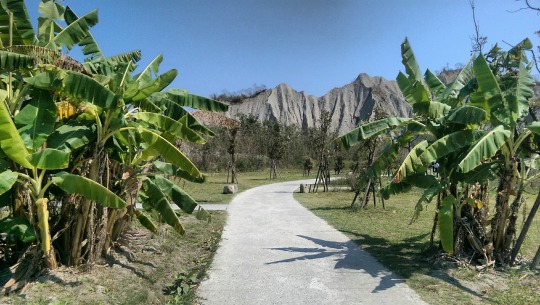
Apologies for the long delay in posting. I’ve been working on a number of personal projects recently, one of which is my new archive site at bgoren.com which is now live. As I mentioned earlier, this blog is going to ease up on the politics and mostly feature travel posts from now on. With a firm date set for our return to the UK (and my employer already notified), we’re looking to visit as many places as possible in Taiwan and the region since it will be prohibitively expensive to do so once we’ve moved. And what a time to move! By the time I am to repatriate it is likely that Brexit will be completed, with all the attendant economic and political problems that’s going to cause. That’s a way off yet (3.5 yrs) though so let’s get back to Taiwan ...
At the end of February, still ‘hungover’ from the Taiwan New Year break and with temperatures hovering annoyingly just over double digits, EVA and I looked at the weather and saw that the minimum temperature down south was higher than the maximum temperature in humid, cold Neihu. No brainer, we booked a place to stay, made a hasty plan for a quick tour, and got on the HSR.
Arriving at Zuoying HSR station, we hired a scooter and set off roughly north-east for Moon World Landscape Park 月世界地景公園, about an hour from the HSR, as seen on the map below ...
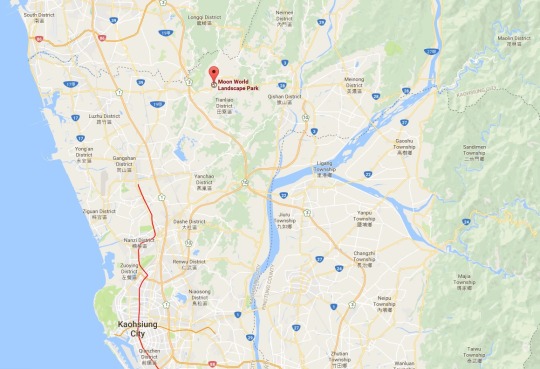
Two things struck me immediately about Moon World. Firstly, the scale, it’s larger than I thought it would be although much of it is off limits to visitors. Secondly, it was an actual tourist site complete with walkways, wooden stairs, and plenty of snacks from vendors to eat. For some reason I had imagined it was a small wild area next to the main road. And, being a holiday, it was busy with tourists such as ourselves enjoying the lovely weather. (Heads up: I was trying a new photo app on my phone but only later realised I had a major problem with the resolution and light settings so all of the pictures of my trip have a strange ‘filter’ on them ...)
Let’s quickly review how this ‘Moon World’ came to exist and the local communities that thrive in and around it. From Kaohsiung City Government ...
Tianliao District covers just under 93 square kilometres and is dominated by undulating hills. Of this hill country, around four fifths is badlands, hence the region's nickname, "Moon World."
Many people wonder how the Moon World badlands came into existence, so we put the question to Professor Chyi Shyh-jeng of the Department of Geography, National Kaohsiung Normal University. Professor Chyi says the area's distinctive mudstone is ocean-floor sediment that was raised by tectonic uplift. Following years of erosion by the area's waterways, such as the Erren River, the mudstone landscape took on its current appearance. Moon World is a result of the mudstone features being weakly lithfied aquitards. Each time it rains, the surface absorbs most of the moisture and expands as a result. Then, when the sun comes out, the surface cracks up because of its dryness. Repeated wetting and drying compromises the surface integrity of the mudstone. Downpours cause landslides, thus forming exposed ridges and gullies that support vegetation only sporadically.
Tianliao's landscape is varied and inspiring. More than 20 movies have been shot hereabouts. In addition to feasting their eyes on this geological and topographical wonder, tourists should know about the local businesses that make the most of the unique landscape, and which make visits to Tianliao even more interesting. The abundance of natural ponds has helped create a thriving aquaculture industry. As you walk past exposed mudstone ridges, you can see their reflections on the surfaces of the fish ponds. The badlands' other unique products include local specialty dishes, such as the much sought after "mud baked chicken." These are locally raised free-range chickens, each one baked in a mud cast. The badlands seem lifeless, yet in fact are a significant source of income for Tianliao residents.
At the entrance to the park ... a family of goats (perhaps left over from a previous Taiwan New Year of the Goat celebration?) welcomed us ...
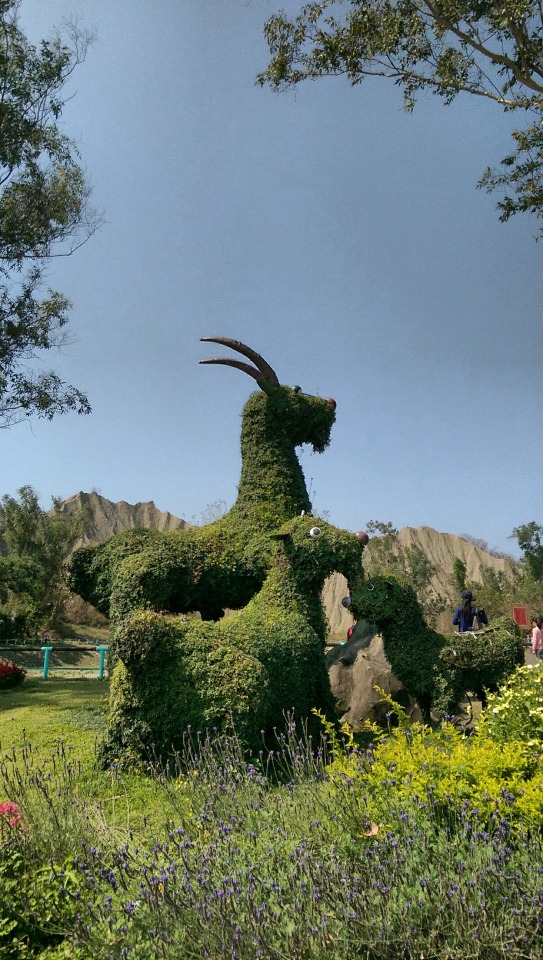
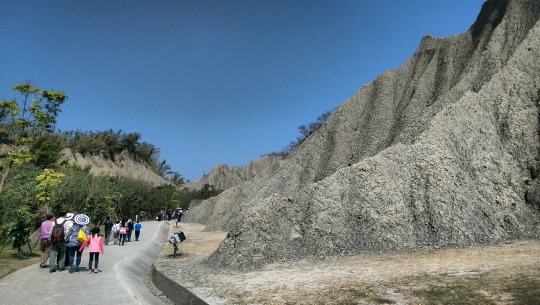
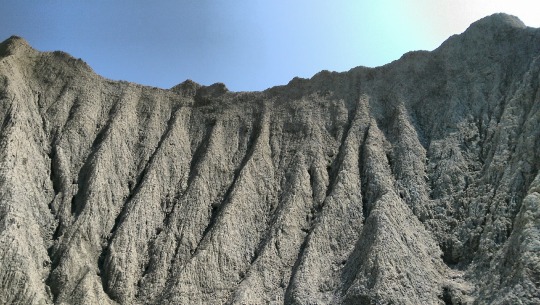
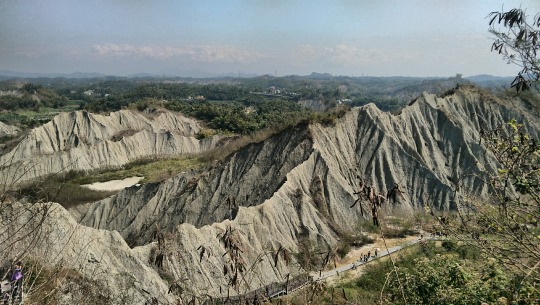
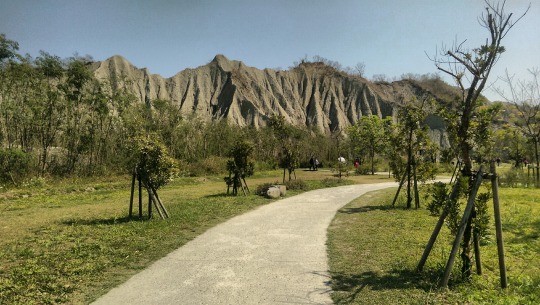

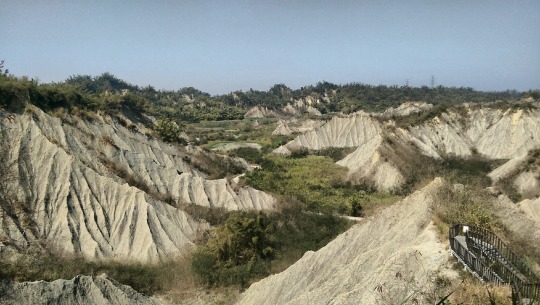
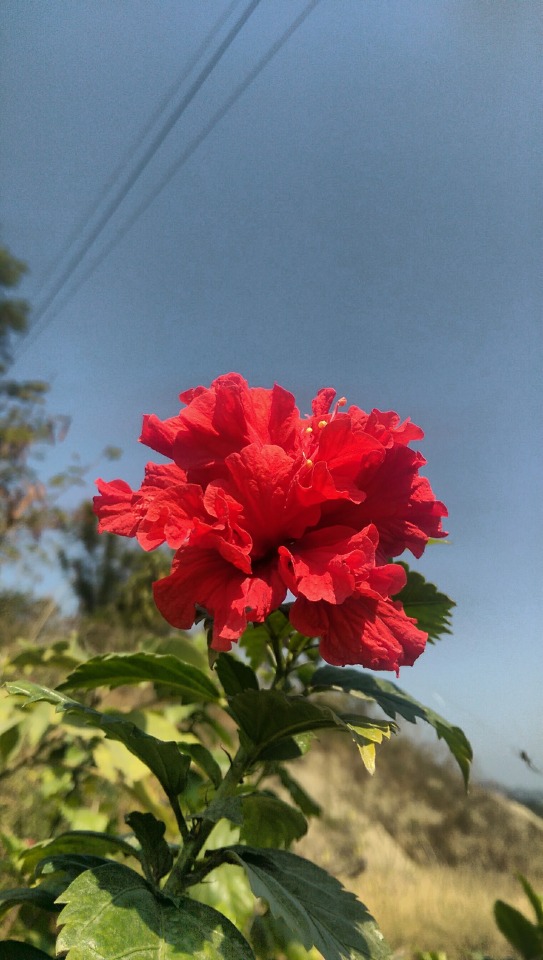
Our plan was to ride on to Chishan and then Meinong to visit the Hakka cultural museum. Chishan is a very pleasant small town with Chishan Old Street that draws tourists for its Japanese era architecture and snacks. It also has a now retired railway station turned into a museum of rail history in the area which, as a fan of trains and history, is like having those extra pennies to buy a 99 Flake ...
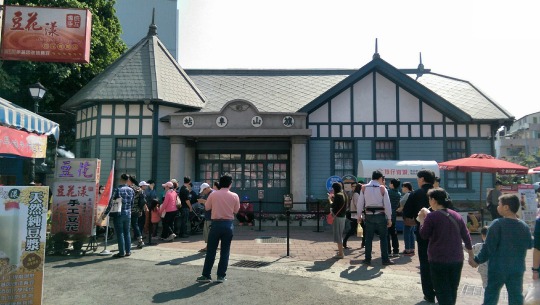

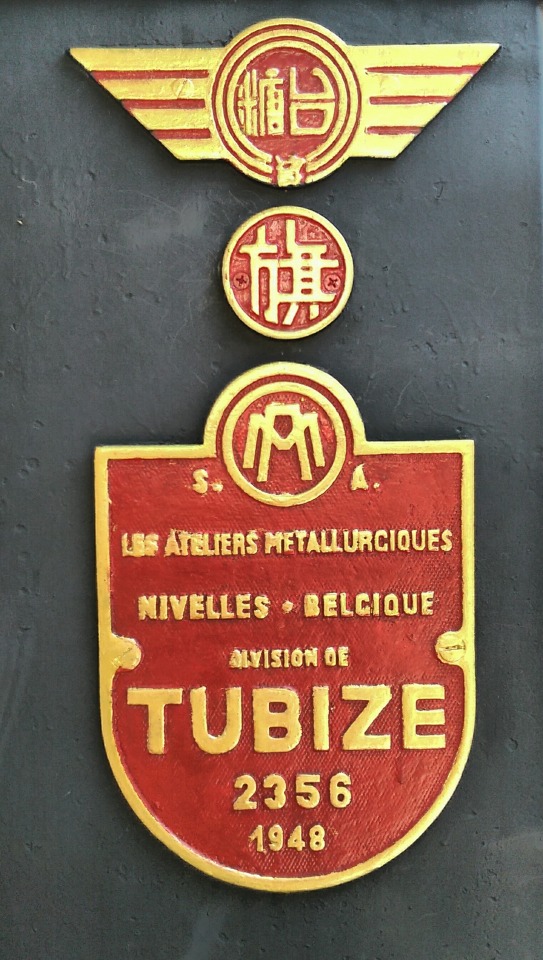
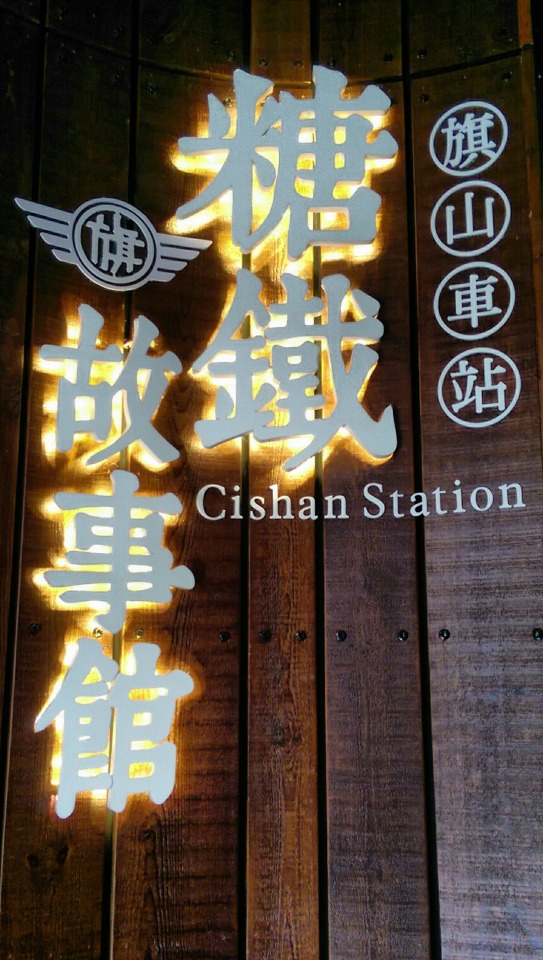
After sampling some pizza (made by Italians who all spoke perfect Mandarin and even some Hoklo) we walked up to the Elementary School that is one of the most aesthetically pleasing I’ve seen in Taiwan. The school’s history begins in the Japanese Colonial Era, which accounts for the splendidly preserved and actively used buildings in the first three pictures below ...
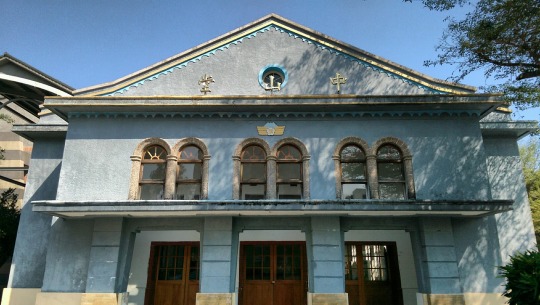
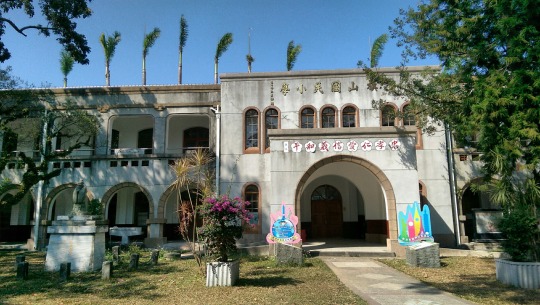
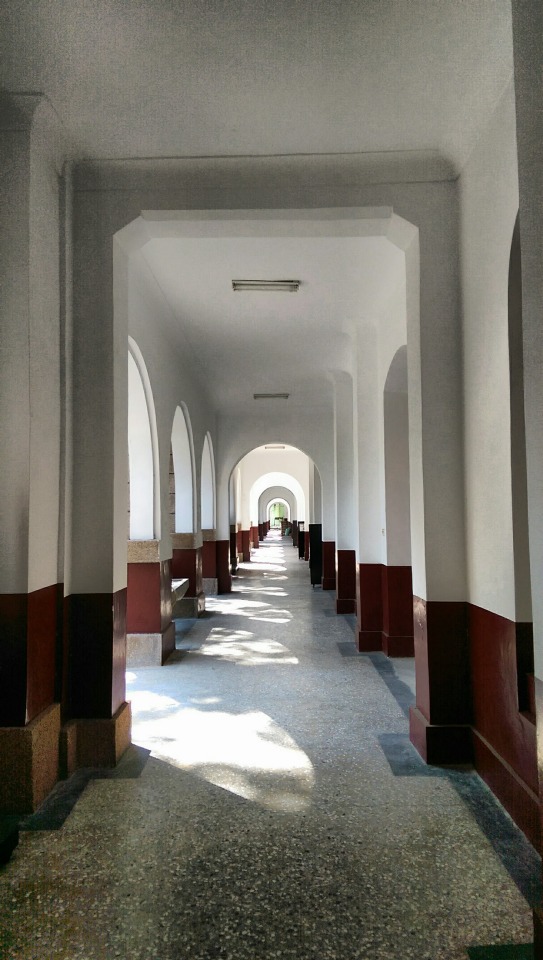
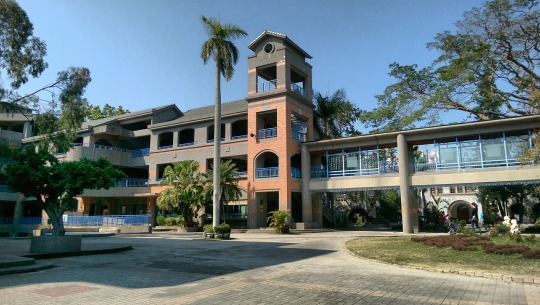
Across the road from the school is a standard park / running track which at the time was host to a local agriculture promoting concert / fair. The park contains a Japanese building (旗山武德殿) and is across from the huge Confucius Temple of Kaohsiung City 旗山孔廟. We waked up the steps for the view. Perhaps another day we’ll return to visit the Temple.

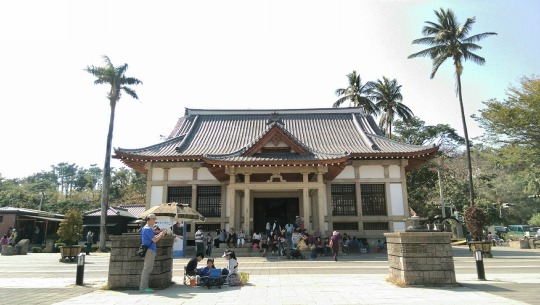

Heading on, we passed over the river into the Meinong valley, and then up Shuren (Zhongshan 2nd Rd.) Road to Meinong Town, finding the Meinong Folk Village (美濃民俗村客家擂茶館) along the way ...
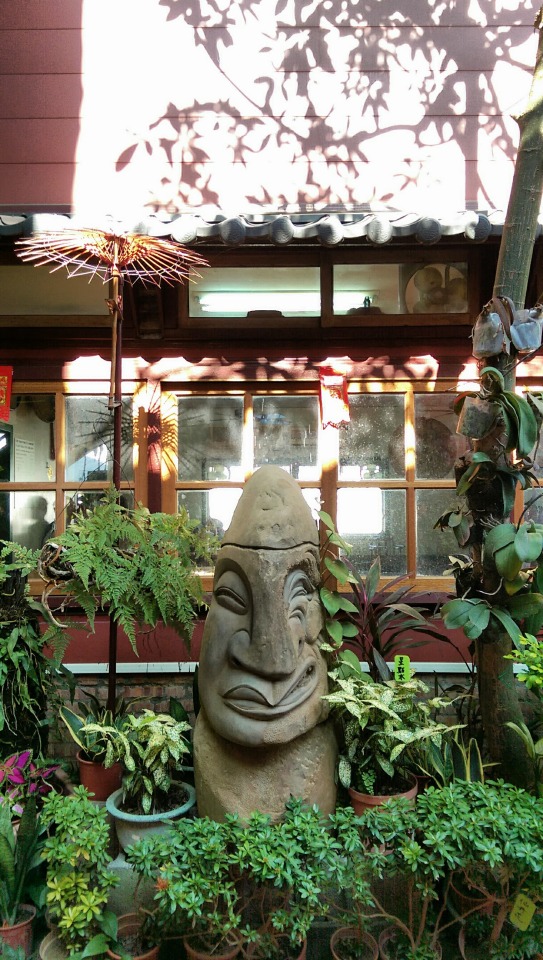


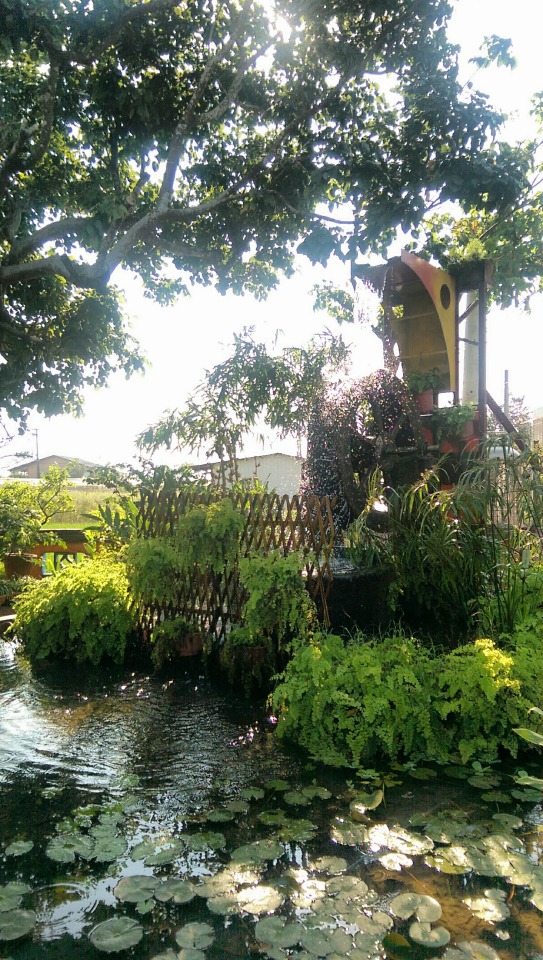
Shielded by mountains to the north and west and with plenty of water flowing through and around the valley, Meinong remains one of Taiwan’s most productive and distinctive agricultural districts. Since I had been to Meinong before I didn’t take any pictures of the town and the Hakka Cultural Museum (Mandarin site, english site here) but I highly recommend going as it is one of the best examples of a Hakka ‘fireline’ town in Taiwan.
Moving on, we drove across the expansive Gaomei Bridge to Gaosu and then took the 27 down to Pingdong City, where we had dinner before crossing the equally impressive and very elevated Gaoping Bridge across and into Kaohsiung City for the night.
The next day we we headed over to Dashu District to visit the Old Iron Bridge Wetland Park, accessible by the TRA’s Jiuqutang Station (九曲堂車站) ...
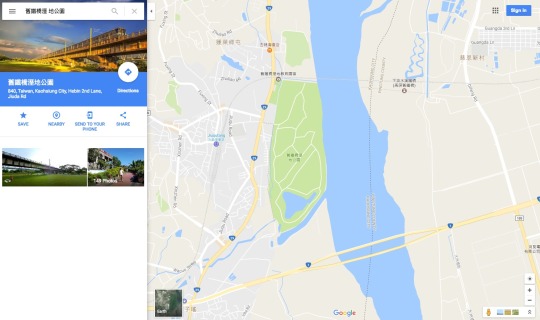
The old railway bridge has quite a history, originally called the Fresh Water Creek Iron Bridge, it was built in early 1913 by the Japanese engineer Yukatani (Toyoji?) Lida. It was at one point the longest span iron bridge in all of Asia ...
... the Bridge is 1,526 meters long and was the most far-stretched iron bridge in Taiwan as well as Asia’s longest bridge at the time. Despite its great contribution to the transportation between Kaohsiung and Pingtung, the bridge gradually worn down with its exposed foundation as a result of river bed erosion, damage brought by the typhoons and expired duration of usage.
The Bridge is an iron-grey steel arc structure with a total of 24 piers built with brick-stones mixed with granite. Most constructions at the time relied heavily on manpower, and KaoPing width and rapid water flow further increased the difficulties in bridge construction. After 8 years, the Bridge was finally accessible.[sic]
... and a tragic history (from Constructing the Colonized Land: Entwined Perspectives of East Asia around WWII, edited by Izumi Kuroishi)

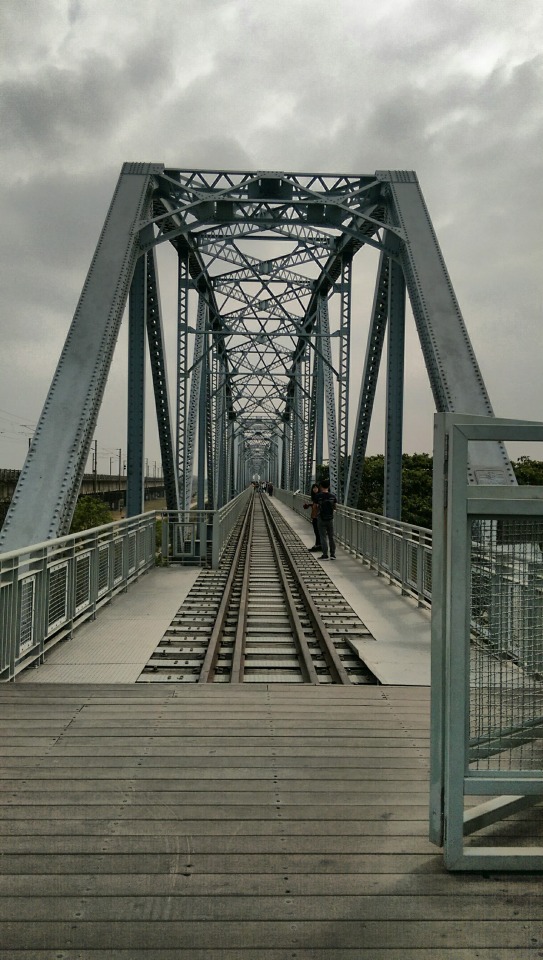
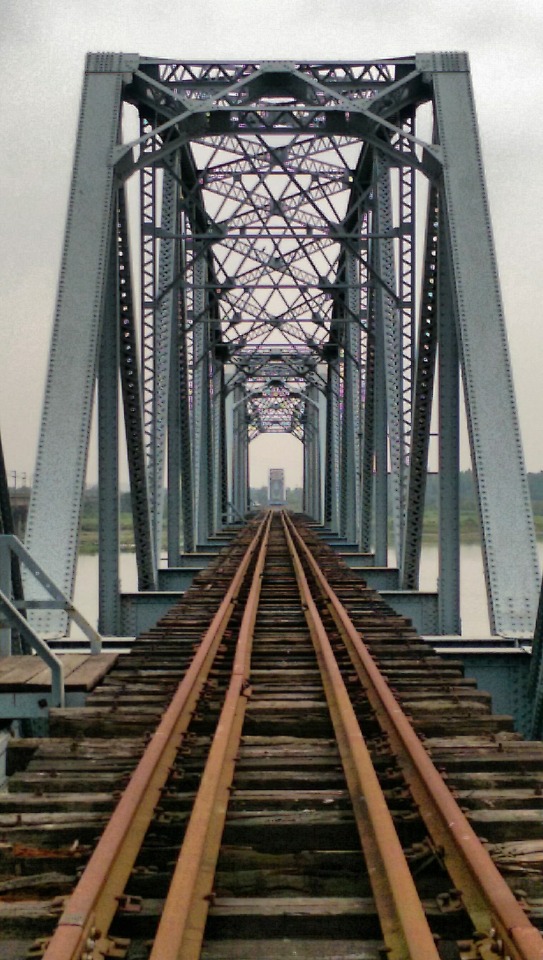
Standing on the bridge is a good place to watch the trains on the newer stronger concrete bridge pass by ...
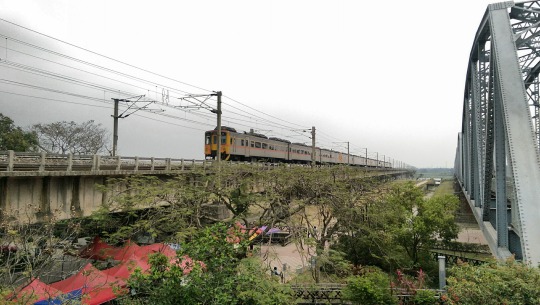
Next to the bridge is not only the wetlands park (a lack of tree cover means it’s probably best to visit in the early morning or late afternoon), but also the Sanhe Tile Kiln complete with a brick/tile gift shop ...
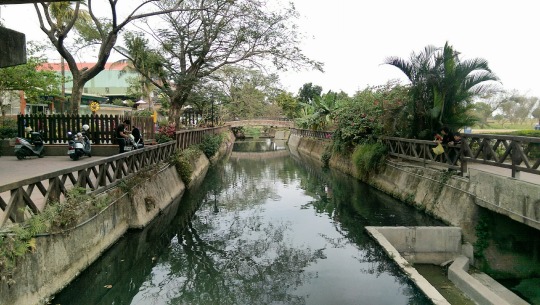

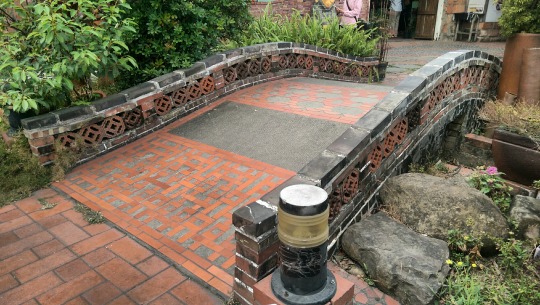
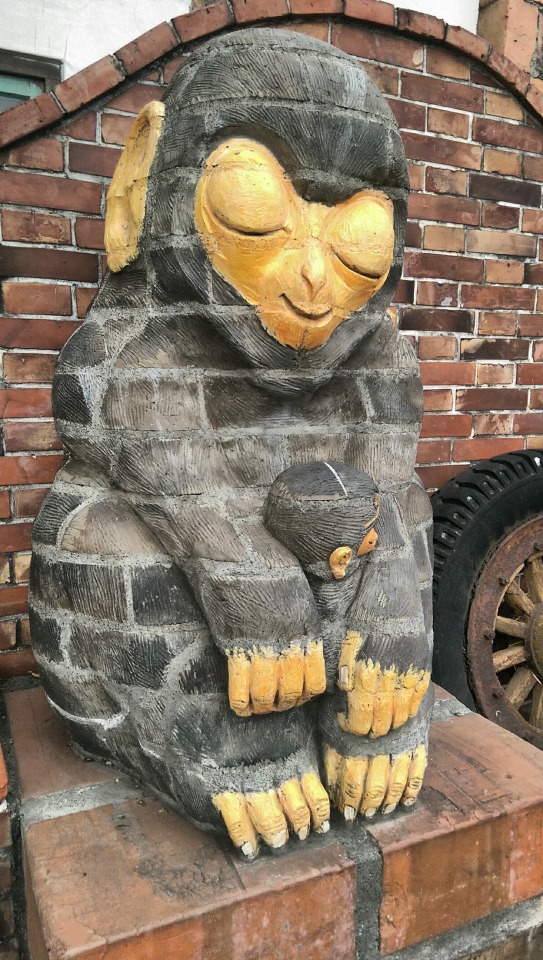
... with a flower bed across the stream ...
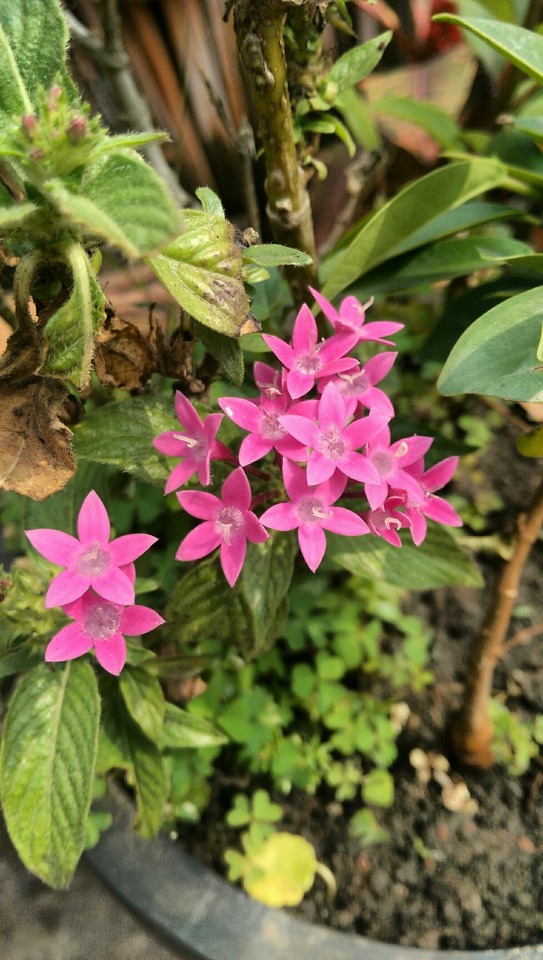

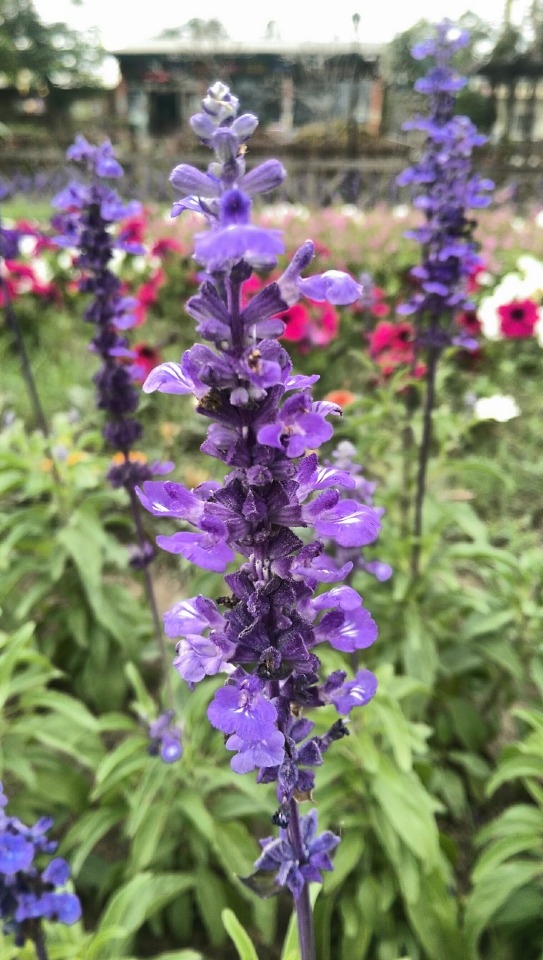
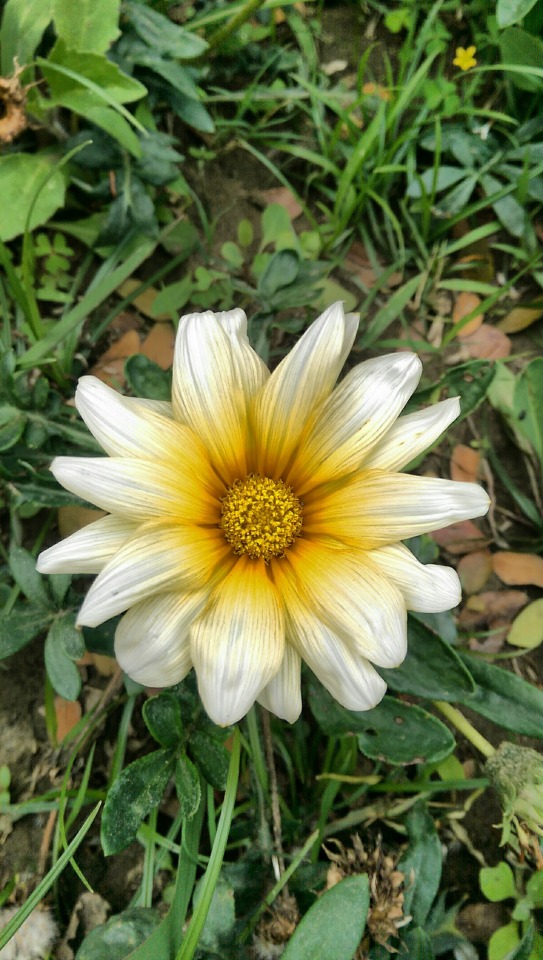
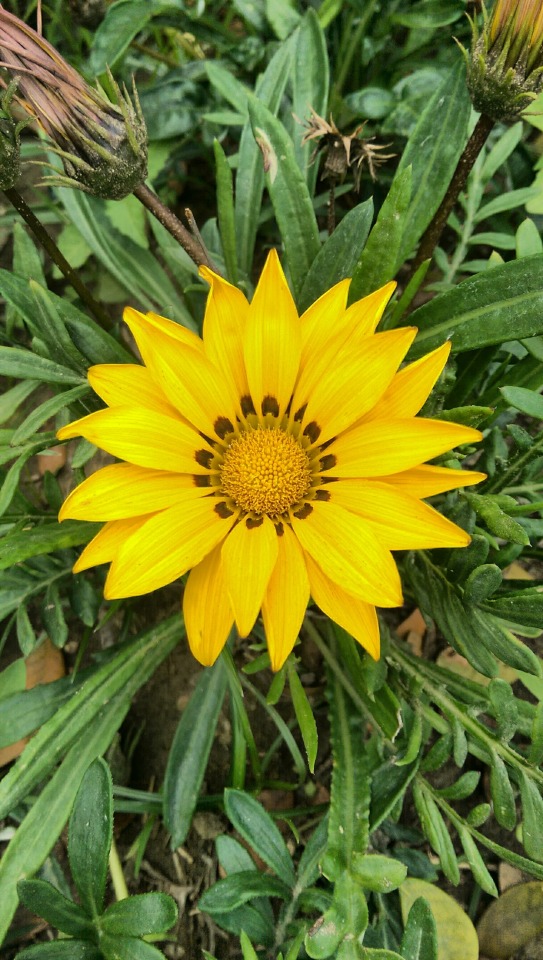
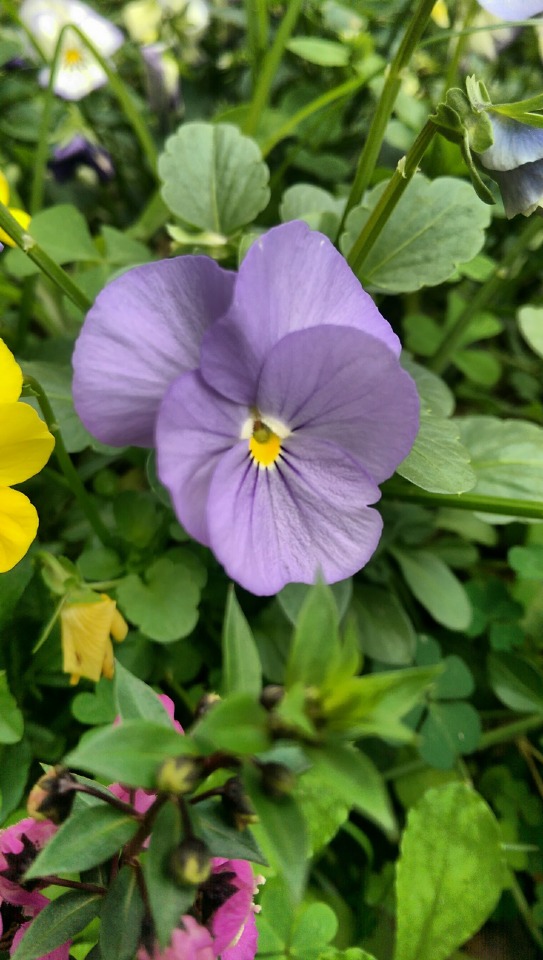
Then it was off to walk around Chengcing Lake 高雄市澄清湖, situated north east of Kaohsiung City in the Niaosong District.
Chengcing Lake, originally called Dabei, a tributary of Tsao Kung River, regulates the irrigation of the surrounding land. In 1952 the Government rebuilt the lake in order to supply water for industrial use. Meanwhile, the Government named it “The Dabei lake”. In 1963, when late President Chiang Kai-shek visited the lake, he changed its name into “Chengcing Lake”.
Apologies again for the poor quality and light in the photos below. The weather wasn’t that dark and cloudy and the lake is pretty although it will undoubtedly be more aesthetically pleasing, as almost every place is, on a bright sunny day ...
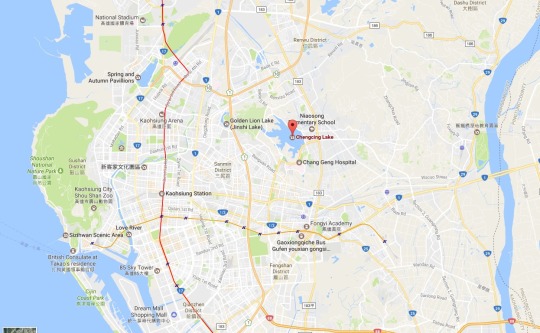
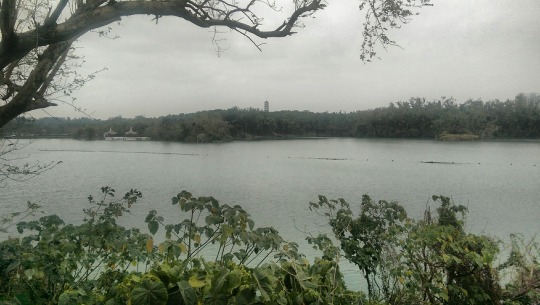
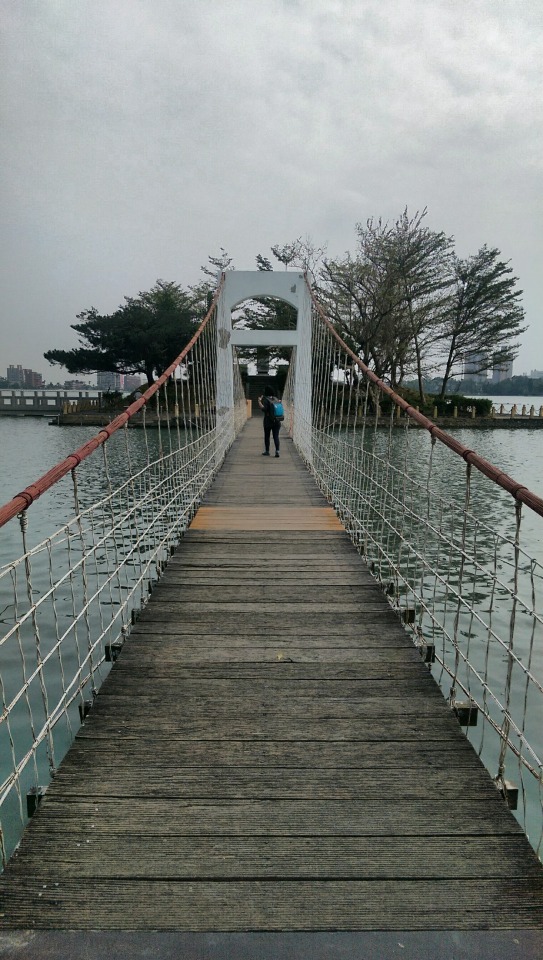
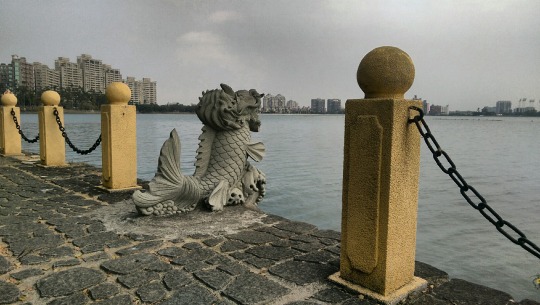
There’s a bell in this tower below that Chiang Kai-shek apparently rang on his visit there, which apparently is significant for some reason other than he liked the sound he made when he rang the bell ...
The bell was constructed in 1969. It’s three floors high with a copper bell hanging on the top floor. The bell used to be struck 105 times specially for the late President Chiang.
However, after President Chiang passed away in 1975 the bell is not struck anymore. In the Buddhism religion, the bell represents peace and dignity. The view looking down from the tower is magnificent and the surroundings are beautiful and and quiet.
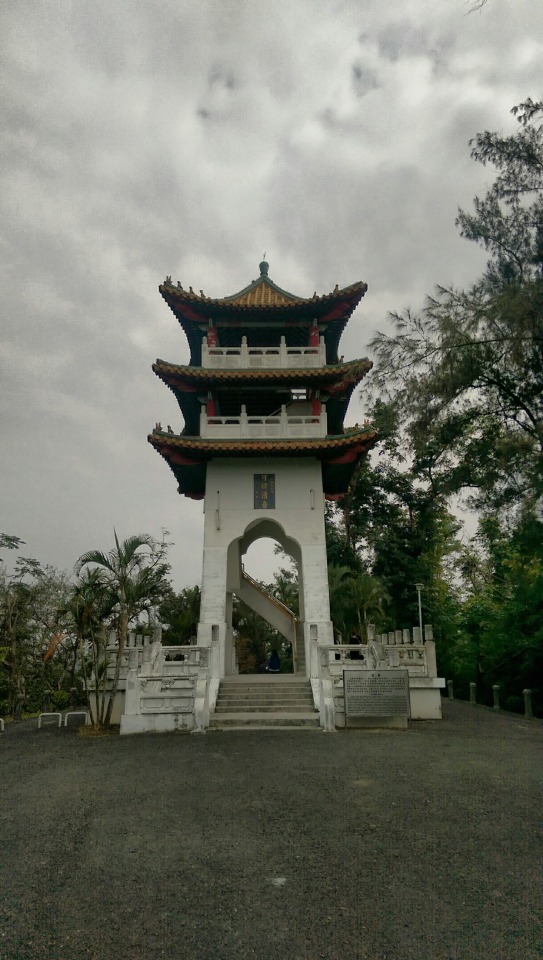
It was when we were walking around the lake that I accidentally dropped my phone off the side of the path down about 10 foot to the water’s edge. Here I am below tentatively collecting it, with guidance and help from a group of other tourists, from amongst the waste leaves and rotten branches thrown over the side following the last typhoon ...
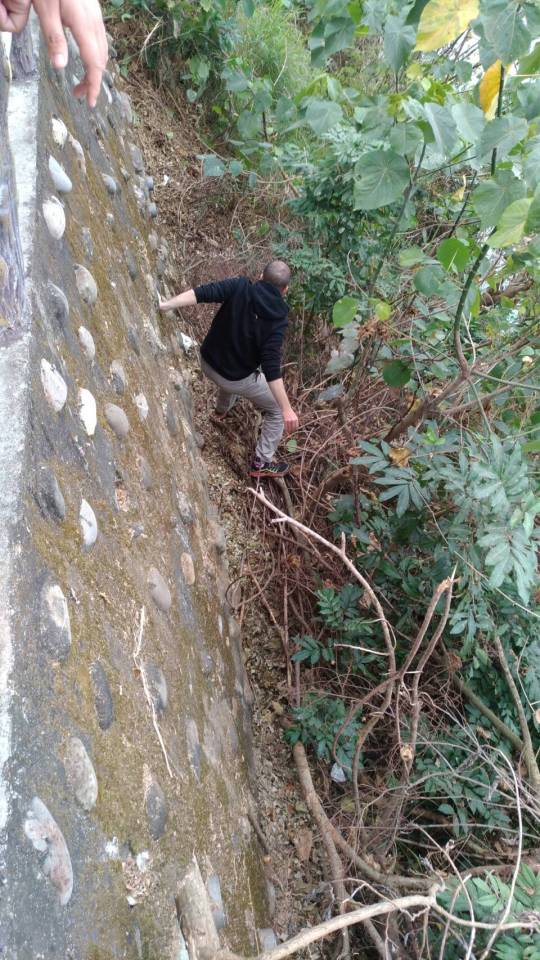
In the evening we stayed at the pleasant and not expensive 停駁 Hostel (No. 9, Lane 7, Gunagrong Street) in Yancheng District, an area of the city which in my opinion is the best place to visit in Kaohsiung in terms of density and variety of attractions. It also easy to access via scooter or MRT ...

On our final morning we drove up north to the Shoushan National Nature Park and specifically Mount Banpingshan (behind from Zuoying HSR Station) where I got to test out a new app Maps.me which was recommended to us by our French scientist couchsurfing guests as a great alternative to Google Maps (because a) you only GPS to use it so no need for an internet signal and b) it shows most of the hiking routes nearly everywhere around the world.) Some background ...
Banpingshan is situated across the Zuoying and Nanzi Districts of Kaohsiung City. Its name is derived from its screen-like appearance. The terrain of Banpingshan is almost spindle shaped; the longitudinal axis is in a northeastern – southwestern direction. The mountain is an independent, single face slanted configuration, with a height of 223 meters. After natural erosion and mining operations, the current height of the mountain is 170m. In the early years during the economical growth periods, Banpingshan was an important mining area for lime, and was excavated by cement factories such as Chientai, Southeast Cement, and Jheng Tai. The natural ecology of the mountain was severely damaged by the long-term mining operations, and the mountain lost its distinctive shape as a result of the excavation. The mining rights at Banpingshan were terminated in 1997, and immediately the mountain underwent a vegetation restoration process. The northwestern part of Banpingshan was designated as a natural park by the Kaohsiung City Government, while the southeastern part was afforested to restore vegetation, and cement industries excavated flood detention sand basins to ensure soil and water retention.
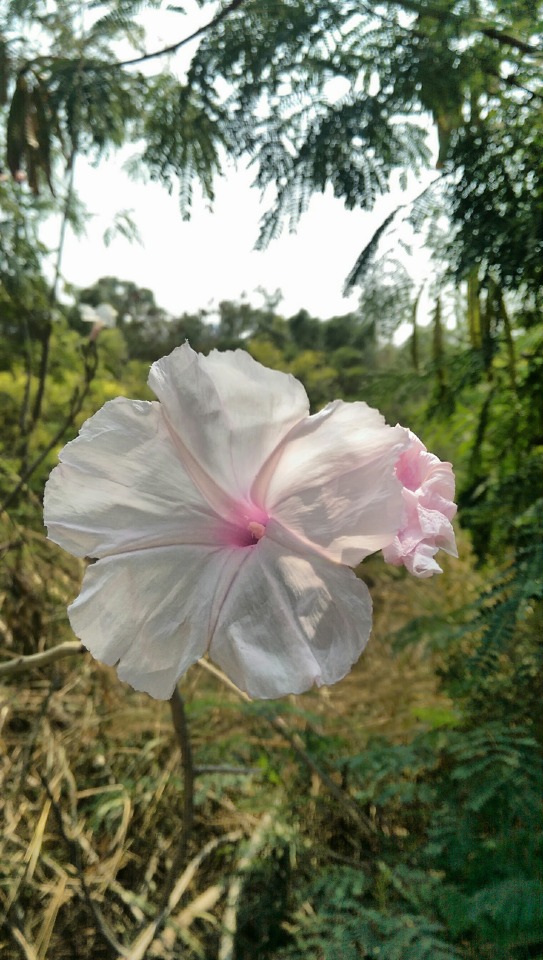
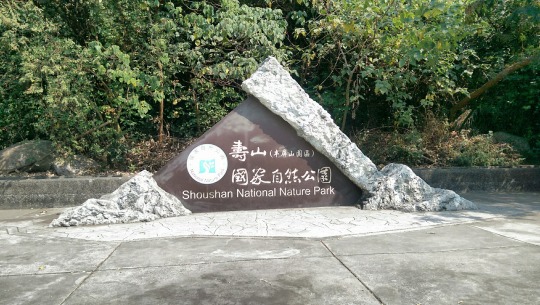
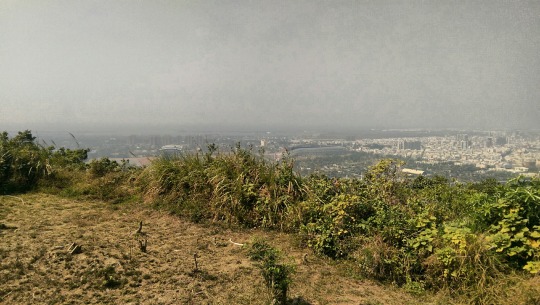
It was a bit hazy but we could still make out the trains, ships, and planes operating nearby. We then descended on the other side of the mountain and walked all the way around Lotus Pond, which features a total of no less than 13 temples and pavilions including one of the largest Confucius Temples in Taiwan. Again, apologies for grainy dark photos ...
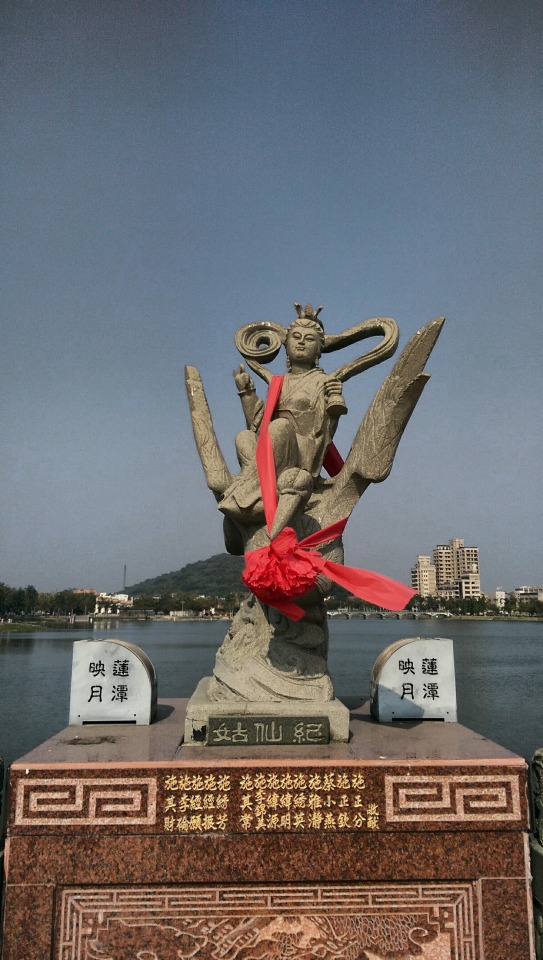
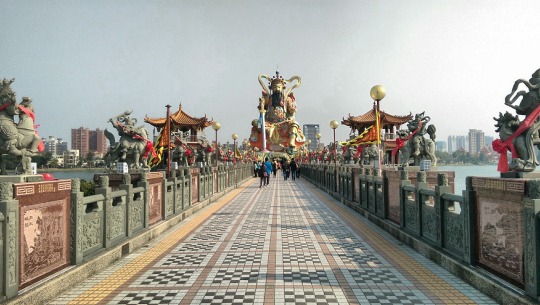
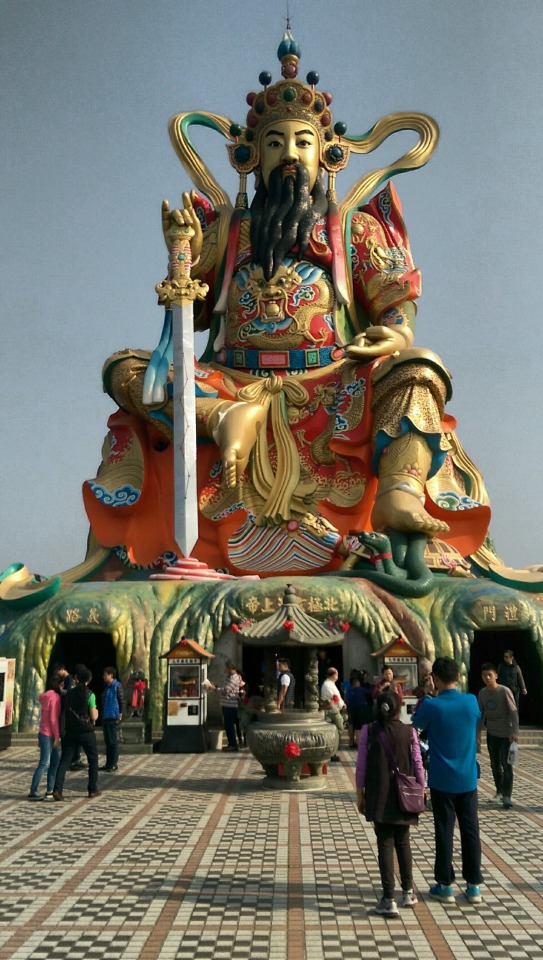
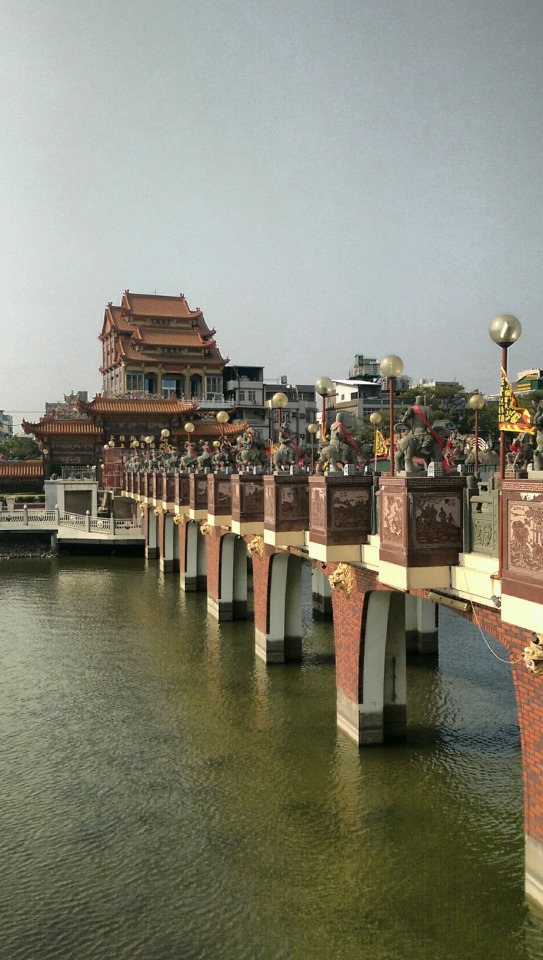

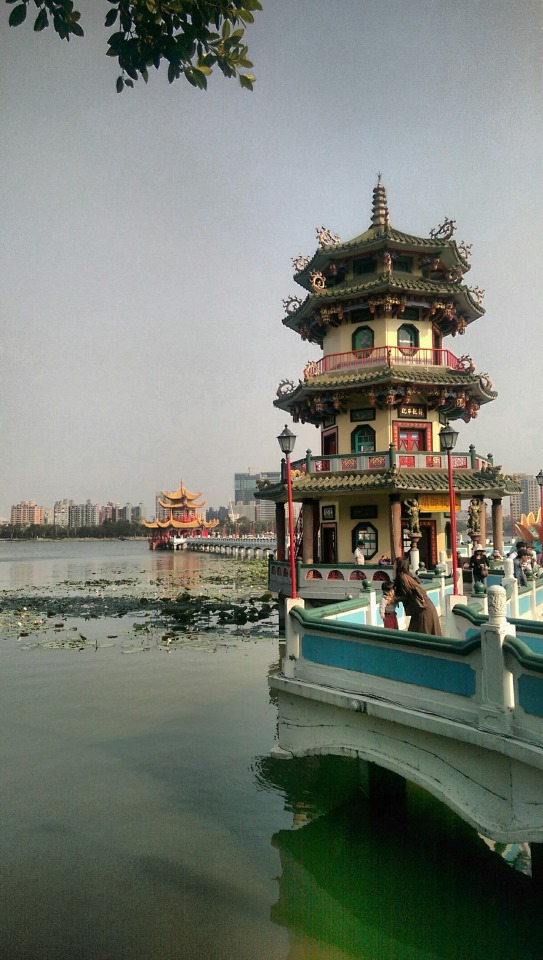
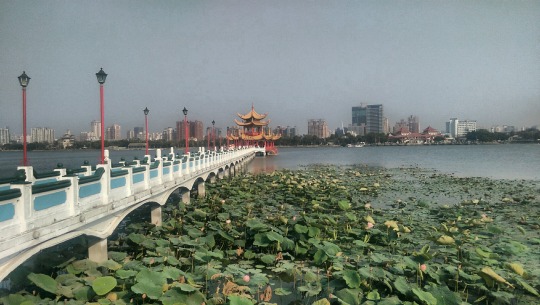
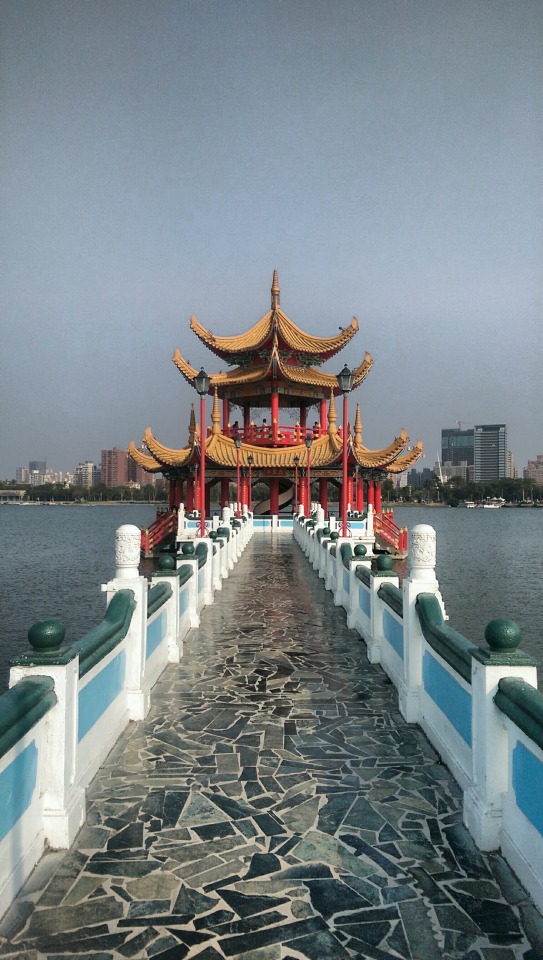

Finally, with feet sore from about five hours constant walking, we headed back to the HSR station for the train home. Of course being the last day of a national holiday the HSR trains were all fully booked leaving only non-reserved seats available. Here’s a tip. When in that situation buy your non-reserved ticket and go down to the platform. Don’t line up for the train already at the platform as you most likely won’t get a seat. Instead, line up for a later train at the adjacent platform, whose queue line will be much shorter, thereby all but guaranteeing you a seat. Yes, you may have to stand in line for about twenty minutes but it beats standing on a train for about ninety, especially after a long day of hiking!
If you have a convenient mode of transport and have planned how to get around well enough, there’s a huge amount you can see in three days and two nights in Taiwan and there’s always somewhere great to hike and eat. Speaking of eating, for our last night we met up with some friends at E95餐酒館 East Ninty Five Bistro (No. 195, Minsheng 1st Rd, Xinxing District, Kaohsiung City, +886 7 222 1238) which served absolutely delicious food. (Note: the bar on the ground floor allows patrons to smoke). Looking forward to visiting Kaohsiung again, next time to visit the lighthouse on Cijin island and more of the city’s less well known or visited attractions.
2 notes
·
View notes
Photo

Kaohsiung's Confucius Temple - The largest Confucius Temple in South East Asia. #Taiwan #Kaohsiung #Qishan #Confucius #Temple #exploretaiwan #iseetaiwan #igerstaiwan #amazingtaiwan #bpintaiwan #taiwagram #discovertaiwan #travel #traveller #travelgram #travelphotography #travelblog #台灣 #高雄 #旗山 #孔廟 #高雄孔廟 (at 高雄市孔子廟)
#高雄#amazingtaiwan#qishan#confucius#kaohsiung#traveller#igerstaiwan#temple#travelblog#孔廟#discovertaiwan#taiwan#travelgram#travelphotography#bpintaiwan#taiwagram#exploretaiwan#高雄孔廟#旗山#iseetaiwan#travel#台灣
3 notes
·
View notes
Text
Incredible Locations To Visit In Taiwan
If you wish to check out a location that is exotic and contains fantastic scenery, Taiwan will be the answer for you. Hawaiian isle country, Taiwan has a prime Southeast Asian culture, tasty cuisines, amazing climate, and diverse forest parts and festivals. The funding capital of scotland - Taipei offers vibrant culture and entertainment. Taiwanese cuisine is rated among the best over a global scale. So once you step into Taiwan, where does one go to feel the full grandiosity of Taiwan? 1. Taipei. The greatest city and the capital of Taiwan, Taipei could be the cultural, arts as well as the natural heartbeat of the landlocked country. Numerous artistic temples specialized in local deities dot the landscape. Famous included in this is the Longshan and Taipei Confucius Temple. Taipei 101 captures your attention because tallest skyscraper in the horizon. On New Year's Eve, the working platform may serve as the tallest fireworks display on the planet. There are several festivals like lantern festival, ghost day celebrations, double ten day etc. These festivals spice up the setting and you should exist to see the impression. Taiwan tour packages are incomplete with an authentic festival experience.

2. Nantou. The second largest city in Taiwan, Nantou hosts the most famous tea plants, the oolong teas. Begin to see the original teas grown fully splendor. The mountainous landscape causes it to be very dear to trekkers and mountain hikers. Notable hiking trails include Maolan and Hanbi hiking trails. Its also wise to definitely check out the Cingjing farm, which delivers luscious farms of oolong trees. 3. Kaohsiung. Looking at the humble roots as being a small trading firm, Kaohsiung has grown into a financial powerhouse. If you have been refining and shipbuilding industries here. The town delivers stable effective infrastructure, which enabled it for hosting 2009 world games. The primary attractions with this beautiful city include, Liuhe Night Market, World games stadium along with a great resource of nature with forests. Taiwan travel packages ensure a stop in Kaohsiung. 4. Hsinchu. Did you know almost all of the worlds' electronic backpacks are made in Taiwan? Your phone probably was developed in Hsinchu, the key electronic manufacturing hub in Taiwan, and in all probability the world. The Hsinchu technological zone is home to IT offices and leading giants like Huawei etc. Have you thought to plainly and require a tour of the world's leading electronic hub? The current styles great discounts while you shop here. 5. Kinmen. Kinmen is truly a band of islands under Taiwanese administration. The major attraction is knives created from the unexploded arsenal during the Chinese Civil War. Kinmen noodles are equally famous being a delicacy. Collect your kinmen knives as being a souvenir making your Taiwan stay memorable. For more details about Du hoc dai loan web site: web link.
0 notes
Photo

New Post has been published on http://crxssart.com/chi-ming-tang-temple-lotus-pond-kaohsiung-taiwan/
Chi-Ming Tang Temple Lotus Pond Kaohsiung Taiwan
Chi-Ming Tang Temple Lotus Pond Kaohsiung Taiwan
The Chi Ming Temple is located across the street from Lotus Pond and is also referred to as the Temple of Enlightenment. It is decorated with red lanterns and has an abundance of color.
The Temple is used to worship Confucius and Lord Guan. Followers believe Confucius to be a god and believers come to offer sacrifices and to worship. There is a lot of gold around the altars and the paintings on the ceilings are exquisite.
Many worshippers purchase
“fake”
money packets and/or food items such as fruit and then offer these as a sacrifice to the gods. This is a definite must see in Kaohsiung.
A little music while you scroll
http://crxssart.com/wp-content/uploads/2017/04/Dj-Onur-Ergin-vs.Rihanna-Dont-Stop-The-MusicRemix.mp3
Policy & Disclaimer
All songs / mp3 / articles / pictures copyright their original owners. I am providing these songs / mp3 / articles / pictures so the reader will not have to rely upon my incapable prose to understand what the music sounds like / better description or Image for visual. I recommend every articles / pictures / art / album / songs / mp3 here and encourage users to buy them / support / support the artist, or to go see one of the artist’s shows. If you are the owner or creator of an item I am hosting, and want me to remove that item, please contact me and I will take it down immediately.
0 notes
Text
Confucius Temple Kaohsiung
Confucius Temple Kaohsiung 高雄孔廟、舊城牆 Confucius Temple、Old City Walls at Kaohsiung Kaohsiung, Taiwan 拍達傳播事業有限公司 paidar-video.com.tw/ 更多資訊請參考我們以上網址
View On WordPress
0 notes